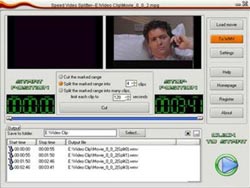Have you stumbled upon an amazing video file, but its size is too large to transfer to your modest USB drive? Splitting the video into smaller parts using file cutting tools seems like the only solution?
 The drawback of conventional file splitting solutions is that unless you have gathered enough segments to reassemble, the video file remains non-functional! Individual segments are just like useless piles of bricks until they are put back together! Fortunately, a tool called “Speed Video Splitter” (SVS) offers an excellent solution by allowing you to split video files into smaller parts that can operate independently. Aside from splitting large video files into smaller segments, SVS also supports converting between various video file formats during the splitting process. It supports almost all popular video file formats today, such as MPG, MPEG, AVI, WMV, ASF… especially the two formats used for VCD and DVD movies: DAT and VOB.
The drawback of conventional file splitting solutions is that unless you have gathered enough segments to reassemble, the video file remains non-functional! Individual segments are just like useless piles of bricks until they are put back together! Fortunately, a tool called “Speed Video Splitter” (SVS) offers an excellent solution by allowing you to split video files into smaller parts that can operate independently. Aside from splitting large video files into smaller segments, SVS also supports converting between various video file formats during the splitting process. It supports almost all popular video file formats today, such as MPG, MPEG, AVI, WMV, ASF… especially the two formats used for VCD and DVD movies: DAT and VOB.
Using SVS is quite simple, thanks to its user-friendly interface. Here’s how to do it:
– Click on the “Load movie” button to locate the video file you need to split.
– Check “Split the marked range into” -> select the number of files to split in the “Clips” box. The average size of a DAT file is about 500 MB; if your memory card is 128 MB, then splitting the DAT file into four parts would be just right.
– Click the “To WMV” button and then choose the appropriate output format for the split file. This unique feature of SVS supports all common video output formats with varying quality levels, from low to high. This functionality is particularly effective when dealing with high-quality, large video files. For example, if you encounter a VOB file larger than 1GB from a DVD, it’s advisable to convert this VOB format to MPEG 1 or 2 for easier transport.
– After selecting the output format, click the “Cut” button to display the names of the split files in the list. Finally, click “Click to Start” for SVS to begin the file splitting and format conversion process. The split files will be saved in the default directory, which is the same as the original file, with the name appended with “(Split*)”, where * is the sequence number of each split file.
To create specific types of video or audio files suitable for different network environments, you should go to “Setting” to choose the appropriate output file type. You can select a small video file format designed for slow networks; a suitable video format for portable devices like PDAs or mobile phones; or a high-quality video file format for high-speed networks of 256KB/second and above…
Users can click here to download the trial version of Speed Video Splitter 2.4.15, which is approximately 3.2 MB, or purchase the official version at software stores.
THIEN TRANG


















































